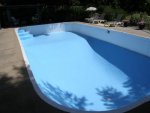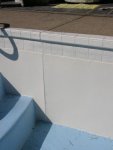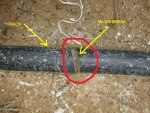OK, not sure where to start but here goes.....I apparently have a leak in my water circulation system. I figure it's in the pressure side (no bubbles in the pump window).
Two seasons ago, one "eyeball" outlet (out of three) began blowing a little sand. The filter checked out -laterals were intact but I replaced a missing lateral screw. Last season the sand problem worsened and I plugged the offending outlet with a winterizing plug as an experiment. I figured that section of line was compromised. That cured the problem until late August, when suddenly I couldn't maintain the water level - the pool began leaking fast. The garden hose couldn't keep up with it.
My theory is that the pressure side line to the one eyeball had cracked or otherwise failed, and was now pumping water into the surrounding soil (mostly sand). Since it was late summer, I closed the pool early and deferred the problem to this season. So, now I'm looking for advice.
I have an old 20 x 40 in ground pool, I think it's called a "Hybrid". The entire bottom(deep and shallow end) is cement, the sides are fiberglass with fiberglass coping. The entire perimeter is covered by concrete sidewalk. It looks like I'm going to have to get behind the fiberglass panels to repair the tubing as a DIY project. Not looking forward to it but the few contractors I've found won't talk to me - they're too busy either opening, closing, constructing new pools, or it's the dead of winter.
I bought the house 16 years ago and the pool came with it. I don't know the actual age but I'm guessing at least 40 years. I've become a semi-expert in pool maintenance over the years, including refurbishing the bottom and sides and repainting twice (it's due for another). Past work included fiberglass crack repair with cloth and/or "bondo-hair". I feel capable of doing the work but I'm getting older and lazier.
I'm just trying to get an idea of what to expect. My idea is to cut out the fiberglass panel where the problem eyeball is located and look for the problem. At least it's in the shallow end.
Questions:
I may end up destroying one or more fiberglass panels. Are replacements available and where? Is there a substitute?
Does anyone have an idea of the most likely location of the eyeball plumbing? Would they be most likely routed close behind and along the fiberglass sides or buried deep under my concrete sidewalks?
How about anyone else with the same problem? Like to hear what was discovered and how it was repaired.
Since one line failed, other sections may also soon follow. Is there another way - like replacing the entire pressure side plumbing with some sort of above-ground substitute?
I'm in SW Michigan. As I write this, there is at least a foot of snow remaining and the temp hasn't been above freezing for weeks. So, I have some time to plan an approach.
Any advice or personal experience will be appreciated.
Two seasons ago, one "eyeball" outlet (out of three) began blowing a little sand. The filter checked out -laterals were intact but I replaced a missing lateral screw. Last season the sand problem worsened and I plugged the offending outlet with a winterizing plug as an experiment. I figured that section of line was compromised. That cured the problem until late August, when suddenly I couldn't maintain the water level - the pool began leaking fast. The garden hose couldn't keep up with it.
My theory is that the pressure side line to the one eyeball had cracked or otherwise failed, and was now pumping water into the surrounding soil (mostly sand). Since it was late summer, I closed the pool early and deferred the problem to this season. So, now I'm looking for advice.
I have an old 20 x 40 in ground pool, I think it's called a "Hybrid". The entire bottom(deep and shallow end) is cement, the sides are fiberglass with fiberglass coping. The entire perimeter is covered by concrete sidewalk. It looks like I'm going to have to get behind the fiberglass panels to repair the tubing as a DIY project. Not looking forward to it but the few contractors I've found won't talk to me - they're too busy either opening, closing, constructing new pools, or it's the dead of winter.
I bought the house 16 years ago and the pool came with it. I don't know the actual age but I'm guessing at least 40 years. I've become a semi-expert in pool maintenance over the years, including refurbishing the bottom and sides and repainting twice (it's due for another). Past work included fiberglass crack repair with cloth and/or "bondo-hair". I feel capable of doing the work but I'm getting older and lazier.
I'm just trying to get an idea of what to expect. My idea is to cut out the fiberglass panel where the problem eyeball is located and look for the problem. At least it's in the shallow end.
Questions:
I may end up destroying one or more fiberglass panels. Are replacements available and where? Is there a substitute?
Does anyone have an idea of the most likely location of the eyeball plumbing? Would they be most likely routed close behind and along the fiberglass sides or buried deep under my concrete sidewalks?
How about anyone else with the same problem? Like to hear what was discovered and how it was repaired.
Since one line failed, other sections may also soon follow. Is there another way - like replacing the entire pressure side plumbing with some sort of above-ground substitute?
I'm in SW Michigan. As I write this, there is at least a foot of snow remaining and the temp hasn't been above freezing for weeks. So, I have some time to plan an approach.
Any advice or personal experience will be appreciated.




